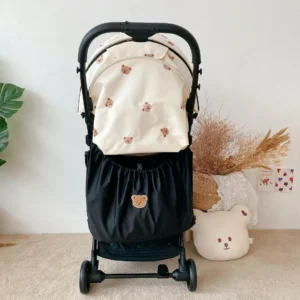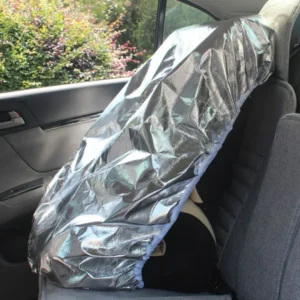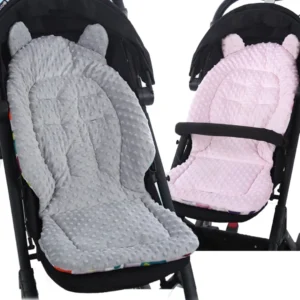Have you ever noticed a strange, musty smell coming from your stroller?
Or maybe you’ve seen dark patches and fuzzy growths appearing on its fabric?
If so, you could be dealing with the pesky problem of mold.
But fear not!
In this guide, we’ll uncover the secrets to getting rid of mold on your stroller and keeping it clean and mold-free for you and your little one.
Say goodbye to that unappealing fungus and hello to a fresh, mold-free ride!
How to get rid of mold on the stroller?
To get rid of mold on a stroller, there are several methods you can try.
First, it’s important to regularly clean and maintain the stroller to prevent mold growth.
Clean the stroller 3-4 times a month or after every use and use a brush to remove dirt and mud from the wheels.
For mild mold stains on fabric, frame, and other parts of the stroller, you can use a solution of water, white vinegar, and lemon juice.
For severe mold stains, try a solution of water and baking soda.
Another option is to make a paste using baking soda and water, or a mixture of white vinegar and baking soda.
Apply the cleaning solutions with a sponge or washcloth.
Clean the stroller canopy using the same process as the seat fabric.
To prevent mold from returning, store the stroller in a cool, dry place.
If it must be stored in a dark and damp place, using citronella anti-fungal spray once a week in the storage area is recommended.
Lastly, keeping the entire house clean can help prevent mold growth.
Key Points:
- Regularly clean and maintain the stroller to prevent mold growth
- Clean the stroller 3-4 times a month or after every use and remove dirt and mud from the wheels
- Use a solution of water, white vinegar, and lemon juice for mild mold stains on fabric, frame, and other parts of the stroller
- Try a solution of water and baking soda for severe mold stains
- Apply cleaning solutions with a sponge or washcloth
- Store the stroller in a cool, dry place to prevent mold from returning
💡 Did You Know?
1. Mold has been known to grow on strollers that are stored in damp or humid environments for extended periods of time.
2. Vinegar, a natural and non-toxic cleaning agent, can be effective in removing mold from strollers. Simply mix equal parts water and vinegar, and scrub the affected areas with a sponge or cloth.
3. Borax, a mineral and household cleaner, can also help eliminate mold on strollers. Mix one cup of borax with one gallon of water, and scrub the affected areas with a brush or sponge.
4. Leaving a stroller in direct sunlight for an extended period of time can help kill mold spores, as they are less likely to thrive in hot, dry conditions.
5. To prevent future mold growth, make sure to thoroughly dry the stroller after cleaning and before storage. Additionally, store the stroller in a dry and well-ventilated area to minimize the chances of mold reappearing.
1. Introduction: Understanding Mold On Strollers
Mold is a type of fungus that thrives in warm and moist conditions, making it a common nuisance in many households. Unfortunately, strollers are not immune to this problem. Mold growth on strollers can pose serious health risks, especially for babies and young children.
In this article, we will explore:
- Causes of mold on strollers
- Potential health risks associated with mold growth on strollers
- Effective methods for cleaning and preventing mold growth on these essential baby accessories.
Mold is a type of fungus that thrives in warm and moist conditions, making it a common nuisance in many households.
Unfortunately, strollers are not immune to this problem. Mold growth on strollers can pose serious health risks, especially for babies and young children.
In this article, we will explore:
- Causes of mold on strollers
- Potential health risks associated with mold growth on strollers
- Effective methods for cleaning and preventing mold growth on these essential baby accessories.
2. Causes Of Mold On Strollers
There are several reasons why mold can develop on a stroller. Leaving the stroller outside exposes it to the elements, including rain and humidity, which create the ideal environment for mold growth. Moreover, leftover food particles can attract mold if not properly cleaned up. Spilled milk, urine, or poop can also contribute to mold growth if not promptly addressed. Additionally, parents accidentally spilling food or drinks on the stroller can unknowingly provide the perfect conditions for mold to thrive.
It is important to note that mold can occur due to both visible and hidden moisture sources. Moist, unventilated areas are particularly susceptible to mold growth. Therefore, it is crucial to regularly clean and dry any damp spots on the stroller to prevent mold from taking hold.
- Leaving the stroller outside in rain and humidity can lead to mold growth
- Leftover food particles can attract mold
- Spilled milk, urine, or poop can contribute to mold growth
- Accidental spills of food or drinks on the stroller can create the perfect conditions for mold to thrive
3. Health Risks And Symptoms Of Mold On Strollers
Mold on a stroller fabric can have detrimental effects on the health of babies and young children. When mold spores are inhaled or ingested, they can cause respiratory challenges, such as gasping for breath, wheezing, and sneezing. In some cases, babies may develop rashes or experience difficulty breathing when exposed to mold.
Newborns, in particular, have weaker immune systems, making them more susceptible to the harmful effects of mold. Hence, it is crucial to keep them away from any mold-infested strollers to ensure their well-being.
4. Cleaning And Removing Mold From Stroller Fabric
Despite the alarming consequences of mold on strollers, there are effective methods for cleaning and removing it from fabric surfaces. First and foremost, contacting the stroller’s manufacturer is essential to ensure that any cleaning agents or methods employed will not cause color bleeding or damage to the fabric.
There are several cleaning recipes that can be used to tackle mold on stroller fabric. A baking soda paste made with water can be applied to the affected areas and left to dry before brushing or vacuuming off any residue. Another option is a paste of vinegar and baking soda, which can also be applied and rinsed off after drying.
For more severe mold stains, a mixture of bleach and water can be utilized. However, caution must be exercised to test the solution on a small, inconspicuous area first to avoid discoloration. It is important to follow the manufacturer’s instructions when using bleach and to thoroughly rinse the fabric after cleaning.
5. Preventing Mold Growth On Strollers
Prevention is key when dealing with mold growth on strollers. Regularly cleaning and maintaining the stroller 3-4 times a month or after every use can significantly reduce the likelihood of mold development. Pay special attention to the wheels and wipe away any stains or sticky messes.
To prevent mold, expose the stroller to direct sunlight immediately after it gets damp, as sunlight effectively kills mold spores. Avoid storing the stroller in dark and wet places, as these conditions promote mold growth. Using a spray of water and baking soda once a month can also help inhibit mold growth.
Another important preventive measure is to keep the entire house clean. Regularly vacuuming and dusting can help minimize the presence of mold spores, reducing the chance of mold growth on strollers and other surfaces.
- Clean the stroller 3-4 times a month or after every use
- Pay special attention to the wheels and wipe away any stains or sticky messes
- Expose the stroller to direct sunlight immediately after it gets damp
- Avoid storing the stroller in dark and wet places
- Use a spray of water and baking soda once a month to inhibit mold growth
- Regularly vacuum and dust the entire house to minimize the presence of mold spores.
6. Additional Tips For Stroller Maintenance And Storage
To prevent mold growth on strollers, in addition to regular cleaning, proper storage is essential. It is advisable to store the stroller in a cool and dry place. However, if it must be stored in a dark and damp area, using a citronella anti-fungal spray once a week can help prevent mold.
When it comes to stroller maintenance, it is important to clean the stroller canopy regularly using the same cleaning solutions as the seat fabric. If the fabric is non-removable, apply the cleaning solutions with a washcloth and gently scrub the affected areas.
Taking ongoing preventive measures is crucial to ensure that mold does not return. Regularly inspect the stroller for any signs of mold or moisture and promptly address any issues that arise.
By following these essential tips and implementing proper cleaning and maintenance techniques, parents can effectively eliminate mold on strollers and create a safe and healthy environment for their little ones.
- Store the stroller in a cool and dry place.
- Use a citronella anti-fungal spray if storing in a dark and damp area.
- Clean the stroller canopy regularly using the same cleaning solutions as the seat fabric.
- Apply cleaning solutions with a washcloth and gently scrub non-removable fabric.
- Regularly inspect the stroller for signs of mold or moisture.
- Promptly address any issues that arise.
FAQ
Can you clean mold off a baby stroller?
Yes, mold can be effectively removed from a baby stroller using a bleach solution. To ensure optimal results, create the solution by combining one cup of bleach with one gallon of water. Thoroughly mix the solution and use a brush to apply it to the mold spots. After scrubbing the affected areas, allow the solution to sit for fifteen minutes. However, it is essential to consult with the stroller manufacturer beforehand to determine if using bleach will have any adverse effects on the fabric design of the stroller.
Why do strollers get moldy?
Strollers can easily become a breeding ground for mold due to a combination of factors. Firstly, when babies spend long periods in strollers, their body heat and perspiration create a moist environment, ideal for mold growth. Secondly, exposure to extreme weather conditions like rain can lead to water seeping into the stroller’s fabric or crevices, providing ample moisture for mold to thrive. Lastly, if baby food spills are not promptly and thoroughly cleaned, the remains can contribute to the growth of mold, as food residue contains organic matter that mold can feed on. Therefore, neglecting to address these common causes of moisture in strollers can lead to unwelcome mold growth.
How do you clean mold off a stroller with vinegar?
To clean mold off a stroller using vinegar, create a solution by combining two parts water with three parts white vinegar in a spray bottle. Thoroughly spray the affected area and allow it to sit for a few minutes. Afterward, wash the entire stroller with soap to remove any remaining mold. For stubborn mold on fabric, if safe to use, a solution of non-chlorine bleach and water can effectively eliminate the mold.
What kills mold spores on fabric?
Hydrogen peroxide is a highly effective solution for eliminating mold spores on fabric. Its strong oxidizing properties break down the mold spores and prevent their growth. You can apply hydrogen peroxide directly to the affected area and leave it to sit for a few minutes before washing the fabric as usual. Another method is to mix hydrogen peroxide with water in a spray bottle and spray the solution onto the fabric. Allow it to dry in sunlight, which also helps eliminate mold spores. Hydrogen peroxide is a safe and affordable alternative for eradicating mold spores from fabric.




